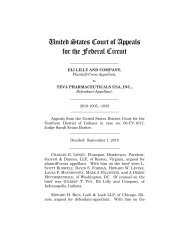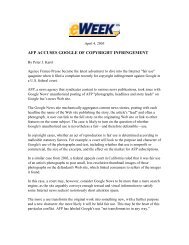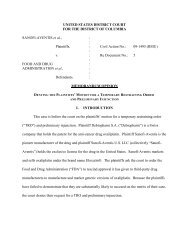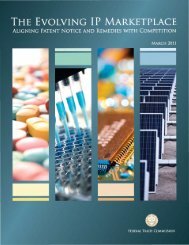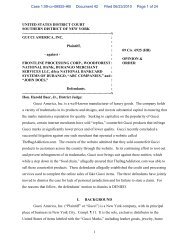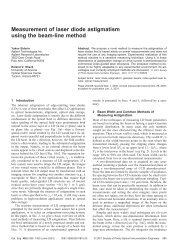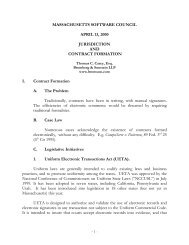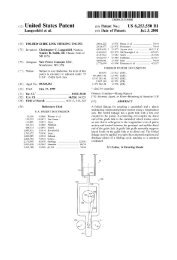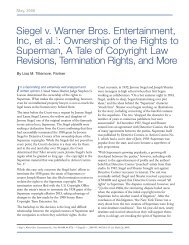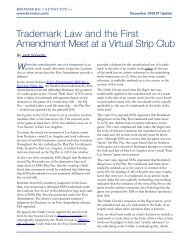Shelby and Ford Take Aim at Counterfeiters
Shelby and Ford Take Aim at Counterfeiters
Shelby and Ford Take Aim at Counterfeiters
You also want an ePaper? Increase the reach of your titles
YUMPU automatically turns print PDFs into web optimized ePapers that Google loves.
SPRING 2002<br />
IMPORTANT. BEFORE READING THIS ARTICLE, YOU MUST READ THE FOLLOWING<br />
LICENSE TERMS AND CLICK THE "I AGREE" BUTTON TO ACCEPT. THIS ARTICLE IS ONLY<br />
FOR THE EDIFICATION OF OUR CLIENTS AND MAY NOT BE USED FOR ANY OTHER<br />
PURPOSE. BY CLICKING THE "I AGREE" BUTTON, YOU ACKNOWLEDGE THAT YOU HAVE<br />
READ AND UNDERSTAND THE TERMS AND THAT YOU AGREE TO BE BOUND BY THEM.<br />
I AGREE<br />
I DO NOT AGREE<br />
Beware of “Clickwrap” Licenses<br />
Of course, nothing prevents you from<br />
reading this article, whether or not you<br />
agree to the terms of use. But most computer<br />
programs today are better protected. Before<br />
installing the program, you will likely be asked to<br />
agree to a so called "clickwrap license or "shrinkwrap"<br />
license. If you agree, you can proceed with the install<strong>at</strong>ion.<br />
If you do not agree, you cannot proceed <strong>and</strong><br />
the software cannot be installed.<br />
Is such a license enforceable? If you are a software<br />
developer, wh<strong>at</strong> must you do to guarantee th<strong>at</strong><br />
this clickwrap license will protect your intellectual<br />
property <strong>and</strong> investment in the software? If you are a<br />
buyer, must you comply with the terms? How can<br />
you modify the often strict terms of the license? Wh<strong>at</strong><br />
law governs these licenses <strong>and</strong> wh<strong>at</strong> implic<strong>at</strong>ions does<br />
th<strong>at</strong> law have for software developers <strong>and</strong> users?<br />
Bromberg & Sunstein LLP recently represented a<br />
computer network consulting company in a groundbreaking<br />
case th<strong>at</strong> <strong>at</strong>tempts to answer these important<br />
questions.<br />
In th<strong>at</strong> case, i.LAN Systems, Inc. v. NetScout Service<br />
Level Corp., Bromberg & Sunstein represented the<br />
buyer of sophistic<strong>at</strong>ed network management software<br />
developed by NetScout's predecessor, NextPoint Networks,<br />
Inc. The buyer, i.LAN, wished to use the software<br />
in its network oper<strong>at</strong>ions center ("NOC") business<br />
to monitor <strong>and</strong> manage the computer networks<br />
of its various clients. To do so, i.LAN needed the right<br />
to install the software on multiple servers simultaneously.<br />
i.LAN thus negoti<strong>at</strong>ed a purchase order for<br />
the software specifying th<strong>at</strong> the software could be used<br />
on multiple computer systems simultaneously to<br />
monitor the networks of multiple clients. Unlike other<br />
purchase orders accepted by NextPoint, which typically<br />
set forth just the software modules purchased,<br />
the quantity, <strong>and</strong> the price, i.LAN's purchase order<br />
contained five specified terms <strong>and</strong> conditions of the<br />
agreement in addition to the software modules <strong>and</strong><br />
price. After i.LAN used the software in this fashion<br />
for some time, a dispute arose between i.LAN <strong>and</strong><br />
NextPoint. NextPoint took the position th<strong>at</strong> i.LAN<br />
was not entitled to use the software on more than<br />
one system <strong>at</strong> a time. During the litig<strong>at</strong>ion, NextPoint,<br />
<strong>and</strong> then its successor, NetScout, argued th<strong>at</strong> the<br />
clickwrap license governed the terms of use, not the<br />
purchase order, <strong>and</strong> th<strong>at</strong> the clickwrap license allowed<br />
only single use, not multiple use. This case thus highlights<br />
the tension between a negoti<strong>at</strong>ed agreement<br />
(the purchase order) <strong>and</strong> the st<strong>and</strong>ardized clickwrap<br />
license th<strong>at</strong>, like the fictional one printed above,<br />
In This Issue<br />
Beware of “Clickwrap” Licenses ........................1<br />
<strong>Shelby</strong> <strong>and</strong> <strong>Ford</strong> <strong>Take</strong> <strong>Aim</strong> <strong>at</strong> <strong>Counterfeiters</strong> ......3<br />
Reluctant Trademark Protection for<br />
Product Designs ...............................................4<br />
Copyright Extensions <strong>at</strong> Issue ...........................6
the DISPATCH<br />
SPRING 2002<br />
appears on the screen before the end user could<br />
complete the install<strong>at</strong>ion. Which agreement should<br />
govern?<br />
The case settled after three days of trial before<br />
Chief Judge Young in the United St<strong>at</strong>es District Court<br />
for the District of Massachusetts. Bromberg & Sunstein<br />
litig<strong>at</strong>ion partner Erik Belt was instrumental in<br />
obtaining a favorable settlement for i.LAN. Before<br />
the case settled, however, Chief Judge Young issued<br />
an opinion which <strong>at</strong>tempted to answer some of these<br />
critical questions.<br />
First, Chief Judge Young<br />
assumed th<strong>at</strong> Article Two of<br />
the Uniform Commercial<br />
Code, which governs the sale<br />
of goods <strong>and</strong> is likely familiar<br />
to most merchants, applies.<br />
Thus, the transaction<br />
for a software license was tre<strong>at</strong>ed like one for the sale<br />
of goods. Second, the court held th<strong>at</strong> the clickwrap<br />
license is enforceable, but only to a certain extent.<br />
Under one possible analysis, the clickwrap license<br />
could be tre<strong>at</strong>ed like a counteroffer under UCC<br />
§ 2-207. Th<strong>at</strong> section provides th<strong>at</strong>, between merchants,<br />
additional terms proposed in a counteroffer<br />
may become part of the contracting parties' agreement<br />
so long as the original offer is silent as to those<br />
terms <strong>and</strong> no objection is made to them. Under a<br />
second possible analysis, § 2-204 would apply. Th<strong>at</strong><br />
section provides th<strong>at</strong> a contract for the sale of goods<br />
may be made <strong>and</strong> accepted by any conduct th<strong>at</strong> recognizes<br />
the existence of the contract. According to<br />
the court, by clicking "I Agree," i.LAN implicitly accepted<br />
the terms of the clickwrap license. The result<br />
of either analysis was th<strong>at</strong> the terms of the purchase<br />
order (i.e., the right to use the software on multiple<br />
systems simultaneously) could apply but th<strong>at</strong> additional<br />
terms found in the clickwrap license, such as<br />
limit<strong>at</strong>ions on liability <strong>and</strong> warranties, would also<br />
apply because the purchase order was silent on those<br />
terms. Thus, i.LAN could still claim the right to use<br />
the software on multiple systems simultaneously, as<br />
provided in the purchase order, but other terms of<br />
the clickwrap license not addressed by the purchase<br />
order would also be enforceable <strong>and</strong> would fill in<br />
the gaps.<br />
“Courts around the country are split on<br />
the enforceability of clickwrap <strong>and</strong><br />
shrinkwrap licenses. One line of cases follows<br />
Step-Saver D<strong>at</strong>a Systems while<br />
another line follows ProCD, Inc.”<br />
The i.LAN case does not end the analysis because<br />
it did not decide whether one agreement was enforceable<br />
to the exclusion of the other. There was still<br />
tension between the two agreements. i.LAN argued<br />
th<strong>at</strong> only the purchase order governed the parties'<br />
rel<strong>at</strong>ionship, while NetScout argued th<strong>at</strong> the clickwrap<br />
license replaced the purchase order entirely. The<br />
court, however, recognized the validity of both agreements.<br />
Indeed, <strong>at</strong> trial, the court instructed the jury<br />
th<strong>at</strong> the purchase order could also be considered as<br />
part of the contract governing<br />
the rel<strong>at</strong>ionship of the<br />
parties.<br />
Courts around the country<br />
have split on the<br />
enforceability of clickwrap<br />
<strong>and</strong> shrinkwrap licenses.<br />
One line of cases follows<br />
Step-Saver D<strong>at</strong>a Systems, Inc.<br />
v. Wyse Technology, 939 F.2d 91 (3d Cir. 1991). In th<strong>at</strong><br />
case, the United St<strong>at</strong>es Court of Appeals refused to<br />
enforce a shrinkwrap license over a purchase order<br />
with specific terms. The purchaser never expressly<br />
assented to the terms of the shrinkwrap, such as by<br />
calling the seller to accept. A second line of cases follows<br />
ProCD, Inc. v. Zeidenberg, 86 F.3d 1447 (7th Cir.<br />
1996), in which the Court of Appeals enforced a<br />
shrinkwrap license because the absence of a timely<br />
objection amounted to assent. In other words, the<br />
terms of the shrinkwrap bind a purchaser who uses<br />
the software after an opportunity to read the terms<br />
<strong>and</strong> to reject them by returning the software.<br />
These two lines of cases can be reconciled, however,<br />
to produce a coherent theory. Step-Saver <strong>and</strong> its<br />
progeny consider wh<strong>at</strong> happens in a business to business<br />
transaction in which there is an opportunity for<br />
the buyer to negoti<strong>at</strong>e with, <strong>and</strong> obtain specific terms<br />
from, the developer. In such cases, those specifically<br />
negoti<strong>at</strong>ed terms should apply. A shrinkwrap license<br />
should not be sprung on a party who has negoti<strong>at</strong>ed<br />
an agreement with the expect<strong>at</strong>ion th<strong>at</strong> it was the<br />
entire agreement. ProCD <strong>and</strong> its progeny consider<br />
mass market or retail transactions to end users, when<br />
there is typically no opportunity to negoti<strong>at</strong>e with<br />
the software developer. In these cases, the buyer goes<br />
to the mall, to main street, or to the web to buy the<br />
2
the DISPATCH<br />
SPRING 2002<br />
software from a retailer. The user never comes in contact<br />
with the software developer. In those cases, it is<br />
more reasonable to enforce the st<strong>and</strong>ardized terms of<br />
the shrinkwrap or clickwrap license.<br />
The i.LAN decision took a middle p<strong>at</strong>h, however,<br />
in enforcing the additional terms of the clickwrap<br />
license but leaving room for enforcement of the<br />
negoti<strong>at</strong>ed purchase order as well. The two agreements<br />
needed to be reconciled. Accordingly, Judge Young<br />
enforced those terms of the clickwrap license as to<br />
which the purchase order was silent. In doing so,<br />
Judge Young steered more closely to the ProCD line<br />
of cases. Although ProCD did not involve a competition<br />
between a negoti<strong>at</strong>ed agreement <strong>and</strong> a st<strong>and</strong>ard<br />
shrinkwrap license, some cases following ProCD have<br />
enforced terms of shrinkwrap licenses even when the<br />
parties exchanged a purchase order containing<br />
specific terms. In those cases, the key was whether<br />
the purchase order was a fully integr<strong>at</strong>ed agreement,<br />
meaning th<strong>at</strong> it contained the entire agreement of<br />
the parties. Taking a cue from these cases, Judge Young<br />
found th<strong>at</strong> the purchase order may set forth part of<br />
the agreement, but so did the clickwrap license.<br />
LESSONS LEARNED: If you are a software<br />
developer, you have much incentive to make sure th<strong>at</strong><br />
all terms of the clickwrap license are enforced, not<br />
just ones th<strong>at</strong> are in addition<br />
to terms on a purchase order<br />
or other negoti<strong>at</strong>ed agreement.<br />
Thus, you should take<br />
care to reference the terms of<br />
the clickwrap, either expressly<br />
or by incorpor<strong>at</strong>ion,<br />
into any purchase order,<br />
invoice, or other document<br />
memorializing a customized sale. Conversely, if you<br />
are a purchaser <strong>and</strong> have spent time <strong>and</strong> effort negoti<strong>at</strong>ing<br />
specific terms, you need to be aware of the<br />
clickwrap <strong>and</strong> refer to it in the negoti<strong>at</strong>ed agreement.<br />
Th<strong>at</strong> is, you will want to make sure th<strong>at</strong> the negoti<strong>at</strong>ed<br />
agreement expressly supercedes any clickwrap<br />
license. The key for either party should be the inclusion<br />
of a properly worded integr<strong>at</strong>ion clause in which<br />
the parties make clear whether the purchase order or<br />
other document memorializes the entire agreement<br />
. . . a growing counterfeit industry has<br />
emerged since 1995 to sell so-called "replicas"<br />
of <strong>Shelby</strong>'s famous COBRAs. The target<br />
market is baby boomers who grew up with<br />
these cars in the 1960's . . .<br />
of the parties, or whether additional terms will be<br />
included.<br />
Erik Belt – ebelt@bromsun.com<br />
617.443.9292x260<br />
<strong>Shelby</strong> <strong>and</strong> <strong>Ford</strong> <strong>Take</strong> <strong>Aim</strong> <strong>at</strong><br />
<strong>Counterfeiters</strong><br />
<strong>Ford</strong> Motor Company <strong>and</strong> racing legend,<br />
Carroll <strong>Shelby</strong>, recently obtained a consent<br />
judgment <strong>and</strong> a comprehensive<br />
injunction against Factory Five Racing, Inc. ("Factory<br />
Five") in federal court in Boston. <strong>Shelby</strong> v Factory Five<br />
Racing, Inc., Civ. No. 00-10409 RWZ; <strong>Ford</strong> Motor Company<br />
v Factory Five Racing, Inc., Civ. No. 00-10399 RWZ.<br />
Factory Five is the largest maker of counterfeit "replicas"<br />
of <strong>Shelby</strong>’s famous COBRAs of the 1960’s. Still<br />
pending is a companion suit against Superformance<br />
Intern<strong>at</strong>ional, Inc., a South Africa based company<br />
which is the number two "replica" maker.<br />
In the lawsuit against<br />
Factory Five, <strong>Shelby</strong> <strong>and</strong> <strong>Ford</strong><br />
claimed th<strong>at</strong> Factory Five's kit<br />
car "replicas" are counterfeits<br />
of the <strong>Shelby</strong> designed<br />
COBRAs. Prior to entry of the<br />
injunction, Factory Five<br />
offered kit cars described as<br />
"COBRA replicas" complete<br />
with exact copies of <strong>Shelby</strong>'s<br />
distinctive COBRA® badge,<br />
<strong>Ford</strong>'s logos, <strong>and</strong> <strong>Shelby</strong>'s<br />
well known 427 S/C®,<br />
FIA 289®, <strong>and</strong> DAYTONA<br />
COUPE COBRA trademarks. <strong>Ford</strong> is the regstered<br />
owner of the COBRA trademark; <strong>Shelby</strong> is <strong>Ford</strong>'s<br />
exclusive licensee. Counterfeiting is prohibited by<br />
provisions of the Lanham Act, 15 U.S.C. §1116. <strong>Shelby</strong><br />
<strong>and</strong> <strong>Ford</strong> claimed also th<strong>at</strong> any unauthorized use of<br />
their trademarks viol<strong>at</strong>es the Federal Trademark<br />
Dilution Act, 15 U.S.C. §1125(c), which provides<br />
enhanced protection to famous marks.<br />
Under the final injunction entered by U.S. District<br />
Judge Rya Zobel, Factory Five is barred from any<br />
3
the DISPATCH<br />
SPRING 2002<br />
direct, indirect, or deriv<strong>at</strong>ive use of the <strong>Shelby</strong> <strong>and</strong><br />
<strong>Ford</strong> trademarks. Factory Five is required also to make<br />
specific disclaimers <strong>and</strong> to inform customers <strong>at</strong> the<br />
time of sale th<strong>at</strong> Factory Five cannot use or authorize<br />
use of the trademarks on its products. In addition,<br />
the court declared the validity of the Plaintiffs' trademarks<br />
against Factory Five's claims of ab<strong>and</strong>onment.<br />
Factory Five entered into a separ<strong>at</strong>e agreement, which<br />
is under seal, to resolve other claims made by <strong>Shelby</strong>.<br />
Bromberg & Sunstein litig<strong>at</strong>ion partners, Ed Dailey<br />
<strong>and</strong> Lisa Fleming represented Carroll <strong>Shelby</strong>. Dailey<br />
noted th<strong>at</strong> a growing counterfeit industry has emerged<br />
since 1995 to sell so-called "replicas" of <strong>Shelby</strong>'s<br />
famous COBRAs. The target market is baby boomers<br />
who grew up with these cars in the 1960's <strong>and</strong> now<br />
want to own an authentic part of their youth. "The<br />
problem," Dailey said, "is th<strong>at</strong> counterfeiters thrive<br />
on misrepresent<strong>at</strong>ion of the<br />
authentic. So it is essential to<br />
halt use of the <strong>Shelby</strong> <strong>and</strong><br />
<strong>Ford</strong> trademarks on these<br />
knock offs." With entry of the<br />
federal court injunction, racing<br />
enthusiasts can no longer<br />
be misled. Now, the only<br />
1960's race car th<strong>at</strong> is a<br />
COBRA <strong>and</strong> can carry the COBRA <strong>and</strong> <strong>Shelby</strong> trademarks<br />
is <strong>Shelby</strong>'s COBRA.<br />
For Carroll <strong>Shelby</strong>, the Factory Five injunction is<br />
vindic<strong>at</strong>ion after a long effort to protect his life's work.<br />
During the 1950's <strong>and</strong> 1960's, Mr. <strong>Shelby</strong> brought<br />
American drivers <strong>and</strong> American race cars to prominence<br />
in intern<strong>at</strong>ional racing. He won LeMans in<br />
1959, the first American to do so. And over the next<br />
seven years, Mr. <strong>Shelby</strong> took <strong>Ford</strong> to the pinnacle of<br />
world racing – making <strong>Ford</strong> in less than ten years the<br />
most successful racing company in the world. With<br />
<strong>Ford</strong>'s backing, engineering, <strong>and</strong> unrivaled engines,<br />
<strong>Shelby</strong> <strong>and</strong> his race team <strong>at</strong> <strong>Shelby</strong> American designed,<br />
engineered, built, <strong>and</strong> raced COBRAs to victory <strong>at</strong><br />
Daytona <strong>and</strong> LeMans. A COBRA took the world manufacturers<br />
title in 1965 <strong>and</strong> 1-2-3 sweeps <strong>at</strong> Daytona,<br />
Sebring, <strong>and</strong> the LeMans 24 hour endurance race in<br />
1966. Then, one of <strong>Shelby</strong>'s race worn DAYTONA<br />
COUPE COBRAs set l<strong>and</strong> endurance speed records <strong>at</strong><br />
Bonneville Fl<strong>at</strong>s.<br />
. . . federal courts have extended trademark<br />
protection to an ever broader range<br />
of unregistered symbols, including product<br />
designs . . . yet, this broadened<br />
protection has been more academic than<br />
real in too many cases.<br />
Mr. <strong>Shelby</strong>'s company, <strong>Shelby</strong> American, continues<br />
to build <strong>and</strong> sell the most famous of the COBRAs,<br />
the 427 S/C. <strong>Ford</strong> uses the COBRA trademark to badge<br />
its high performance MUSTANG. The COBRA trademark<br />
was first used on MUSTANGs specially built by<br />
<strong>Shelby</strong> American in the l<strong>at</strong>e 1960's.<br />
Lisa Fleming – lfleming@bromsun.com<br />
617.443.9292x248<br />
Ed Dailey – edailey@bromsun.com<br />
617.443.9292x233<br />
Reluctant Trademark Protection for<br />
Product Designs<br />
Recognizing the breadth of the Lanham Act<br />
definition of a trademark (it includes "any<br />
word, name, symbol, or devise, or any<br />
combin<strong>at</strong>ion thereof", 15<br />
U.S.C. §1127), federal courts<br />
have extended trademark<br />
protection to an ever broader<br />
range of unregistered symbols,<br />
including product<br />
designs ranging from the<br />
famous COKE® bottle to<br />
faucet <strong>and</strong> clothing designs under section 43(a)(3),<br />
15 U.S.C. §1125(a)(3). Wal-Mart Stores, Inc. v Samara<br />
Bros., Inc., 529 U.S. 205, 209 (1999). Yet, this broadened<br />
protection has been more academic than real in<br />
too many cases because of judicial reluctance to settle<br />
on an analytical method for proof of the key elements<br />
of design infringement.<br />
Non-Functional Design<br />
Where a claim of product design infringement is<br />
raised, the plaintiff cannot simply pursue a conventional<br />
infringement <strong>and</strong> likelihood of confusion str<strong>at</strong>egy.<br />
The plaintiff must first prove th<strong>at</strong> the design is<br />
not functional <strong>and</strong> next th<strong>at</strong> it is distinctive or has<br />
acquired secondary meaning. Wal-Mart <strong>at</strong> 210, 212.<br />
Section 43(a)(3) of the Lanham Act sets the nonfunctional<br />
design requirement while case law has<br />
established the requirement for secondary meaning.<br />
Functional design or functional elements of a design<br />
will not be protected by trademark laws because th<strong>at</strong><br />
would restrain marketplace competition; no other<br />
4
the DISPATCH<br />
SPRING 2002<br />
manufacturer would be able to produce a similar product,<br />
regardless of its design, if underlying functional<br />
elements were protected. Qualitex Co. v Jacobson Products<br />
Co., 514 U.S. 159, 164 (1995); I.P. Lund Trading<br />
ApS v Kohler Co., 163 F.3d 27, 36-38 (1st Cir. 1998).<br />
Furthermore, trademark protection of functional<br />
elements of a design with its unlimited term would<br />
conflict with p<strong>at</strong>ent law <strong>and</strong> the p<strong>at</strong>ent protection<br />
provisions of the Constitution. P<strong>at</strong>ent law limits functional<br />
protection to a finite term of 14 to 20 years.<br />
Lund, 163 F.3d <strong>at</strong> 38, 51-52.<br />
While it a straightforward proposition to limit<br />
trademark protection to non functional design,<br />
applic<strong>at</strong>ion of this rule is complic<strong>at</strong>ed because most<br />
product designs have both functional <strong>and</strong> non functional<br />
elements th<strong>at</strong> cannot be separ<strong>at</strong>ed readily. For<br />
example, it is likely th<strong>at</strong> the body of a race car has<br />
been designed with both functional <strong>and</strong> aesthetic<br />
purposes. It may have flared fenders to accommod<strong>at</strong>e<br />
racing tires <strong>and</strong> a large air scoop to cool the engine,<br />
both functional purposes. However, the design of the<br />
fender flares <strong>and</strong> air scoop may well be influenced by<br />
aesthetics; <strong>and</strong> here, federal courts have moved in the<br />
direction of a practical rule – although it has yet to be<br />
clearly st<strong>at</strong>ed. Where the design has both aesthetic<br />
<strong>and</strong> functional elements <strong>and</strong> where protection of the<br />
overall design is not likely to restrain competition for<br />
similar products, the emerging rule is th<strong>at</strong> the design<br />
is likely to meet the non functional test. Wal-Mart <strong>at</strong><br />
210; Lund, 163 F.3d <strong>at</strong> 37; Chrysler Corp. v Vanzant, 44<br />
F. Supp.2d 1062, 1070 (C.D. Cal. 1999) <strong>and</strong> Esercizio v<br />
Roberts, 944 F.2d 1235, 1240 (6th Cir. 1991 [protection<br />
of a sports car design will not bar other sports<br />
car designs]; I.P. Lund Trading ApS v Kohler Co., 118 F.<br />
Supp.2d 92, 102,103 (D. Mass. 2000) [protection of<br />
one faucet design will not bar<br />
competing designs].<br />
Secondary Meaning<br />
Next, the plaintiff must<br />
prove th<strong>at</strong> the design has<br />
acquired secondary meaning<br />
<strong>and</strong>, in effect, has become a<br />
trademark. This means th<strong>at</strong><br />
in the perception of knowledgeable consumers, the<br />
design or "total appearance of the product" must serve<br />
The problem with the current definition<br />
of secondary meaning is th<strong>at</strong> perceptual<br />
distinctions between identific<strong>at</strong>ion of the<br />
product <strong>and</strong> identific<strong>at</strong>ion of design<br />
source, br<strong>and</strong>, or producer of th<strong>at</strong> product<br />
are subtle <strong>at</strong> best.<br />
primarily as the identifier of the design source, br<strong>and</strong>,<br />
or producer of the product r<strong>at</strong>her than simply as an<br />
identifier of the product. Wal-Mart <strong>at</strong> 211; Lund, 118<br />
F. Supp.2d <strong>at</strong> 103-104 (D. Mass. 2000), citing Esercizio<br />
v Roberts, 944 F.2d <strong>at</strong> 1240. The problem with this<br />
definition of secondary meaning is th<strong>at</strong> perceptual<br />
distinctions between identific<strong>at</strong>ion of the product <strong>and</strong><br />
identific<strong>at</strong>ion of design source, br<strong>and</strong>, or producer of<br />
th<strong>at</strong> product are subtle <strong>at</strong> best. Perceptual distinctions<br />
cannot be assessed readily by conventional survey<br />
protocols. When a consumer identifies a COKE bottle<br />
as COKE or a SHELBY® COBRA® race car as a<br />
COBRA, is th<strong>at</strong> identific<strong>at</strong>ion of the product or the<br />
design? And does th<strong>at</strong> identific<strong>at</strong>ion serve primarily<br />
to identify the design source, br<strong>and</strong>, or producer of<br />
the product? The answer is th<strong>at</strong> it is virtually impossible<br />
to distinguish between product <strong>and</strong> design.<br />
While some survey experts have made a thriving<br />
practice by proclaiming th<strong>at</strong> their survey instruments<br />
can distinguish between perceptions of product <strong>and</strong><br />
design, there is a substantial <strong>and</strong> growing counter.<br />
Indeed, sociology professor Gerald Zaltman, director<br />
of the "mind of the market" labor<strong>at</strong>ory in the Division<br />
of Research <strong>at</strong> Harvard Business School, argues<br />
th<strong>at</strong> consumer perceptions cannot be gauged by<br />
conventional survey tools. Zaltman <strong>and</strong> his colleagues<br />
embrace the insights of cognitive science: thinking is<br />
largely a process of unconscious, visual imagery. Thus,<br />
thought <strong>and</strong> perception can be gauged only by seeking<br />
visual imagery as "metaphors" for thought <strong>and</strong><br />
then using the imagery to verbalize thoughts, emotions,<br />
associ<strong>at</strong>ions, <strong>and</strong> perceptions. See R. Higie <strong>and</strong><br />
G. Zaltman, "Using the Zaltman Metaphor Elicit<strong>at</strong>ion<br />
Technique to Underst<strong>and</strong> Br<strong>and</strong> Images" in Advances<br />
in Consumer Research (Provo, Utah Associ<strong>at</strong>ion for<br />
Consumer Research 1994).<br />
Survey techniques which<br />
rely on nothing more than<br />
verbal responses cannot<br />
gauge perception <strong>and</strong> thus<br />
are incapable of distinguishing<br />
between product <strong>and</strong><br />
design.<br />
Perhaps sensing the limits of conventional<br />
survey research, federal courts have avoided efforts<br />
5
the DISPATCH<br />
SPRING 2002<br />
to distinguish between product or design significance<br />
<strong>and</strong> simply r<strong>at</strong>ify secondary meaning where survey<br />
evidence shows th<strong>at</strong> <strong>at</strong> least 50% of knowledgeable<br />
consumers associ<strong>at</strong>e the product with a single design<br />
source, br<strong>and</strong>, or producer. Spraying Systems Company<br />
v Delavan, Inc., 975 F.2d 387, 394 (7th Cir. 1992).<br />
Courts have also found secondary meaning solely on<br />
the basis of intentional copying of a design. Esercizio<br />
v Roberts, 944 F.2d <strong>at</strong> 1239. In light of the growing<br />
skepticism about the limits of survey protocols, these<br />
approaches seem prudent. However, courts in the<br />
influential First Circuit have taken a different tack.<br />
Far from questioning the capacity of surveys to<br />
distinguish between perceptions of product <strong>and</strong><br />
design, the First Circuit has encouraged federal trial<br />
courts to pursue a "subjective [analysis], looking into<br />
the minds of potential consumers". Lund, 163 F.3d <strong>at</strong><br />
42. The result is questionable <strong>at</strong> best.<br />
Lund involved a dispute over rights to the<br />
plaintiff’s design for a faucet. Lund, a Dutch<br />
manufacturer of high end kitchen <strong>and</strong> b<strong>at</strong>h fixtures,<br />
challenged a similar faucet designed by Kohler, the<br />
largest American manufacturer of plumbing fixtures.<br />
Kohler admitted th<strong>at</strong> its design was based on the Lund<br />
design. After the First Circuit's review <strong>and</strong> reversal of<br />
a preliminary injunction, the case was rem<strong>and</strong>ed to<br />
the district court with the appell<strong>at</strong>e court's invit<strong>at</strong>ion<br />
to pursue survey analysis of consumer perceptions for<br />
secondary meaning.<br />
Lund's survey model followed the established<br />
approach <strong>and</strong> <strong>at</strong>tempted to gauge the extent to which<br />
knowledgeable consumers associ<strong>at</strong>ed the Lund<br />
faucet design with the plaintiff. The case should have<br />
ended there because far less than 50% of the survey<br />
respondents associ<strong>at</strong>ed Lund with the faucet. Lund,<br />
118 F. Supp.2d <strong>at</strong> 106-107. But the court pressed on,<br />
declaring th<strong>at</strong> a plaintiff is oblig<strong>at</strong>ed to prove the<br />
subjective proposition th<strong>at</strong> the design or "total<br />
appearance of the product" serves primarily to identify<br />
the design source, br<strong>and</strong>, or producer of the<br />
product. Lund, 118 F. Supp.2d <strong>at</strong> 109. Then, without<br />
questioning the capacity of conventional survey<br />
protocols to assess perceptions <strong>at</strong> this level, the district<br />
court accepted a biased, leading question survey<br />
from the defendant. Needless to say, the survey<br />
instrument led respondents away from a secondary<br />
meaning response. Lund, 118 F. Supp.2d <strong>at</strong> 110-111.<br />
The Lund courts have assumed th<strong>at</strong> survey instruments<br />
can probe <strong>and</strong> objectively distinguish between<br />
perceptions of product <strong>and</strong> design <strong>and</strong> can determine<br />
the extent to which design functions primarily to<br />
identify the design source, br<strong>and</strong>, or producer. Apart<br />
from the fact th<strong>at</strong> survey experts proclaim this capacity,<br />
however, there is no scientific valid<strong>at</strong>ion th<strong>at</strong><br />
conventional verbal surveys can gauge perceptions.<br />
Furthermore, Zaltman's critique challenges the<br />
capacity of a verbally based survey system to gauge<br />
perceptions in any meaningful way.<br />
At the least, this raises a substantial question<br />
concerning the use of perceptual survey evidence for<br />
secondary meaning under Daubert v Merrell Dow<br />
Pharmaceuticals, Inc., 509 U.S. 579 (1993). Where, as<br />
here, the capacity of a survey protocol to gauge perceptions<br />
cannot be valid<strong>at</strong>ed by independent testing<br />
<strong>and</strong> where it has been questioned within the scientific<br />
community, federal courts should be reluctant<br />
to follow the Lund analysis. R<strong>at</strong>her, the more limited<br />
use of survey work as recognized in Spraying Systems<br />
Company or the altern<strong>at</strong>ive recognition of intentional<br />
copying as indic<strong>at</strong>ive of secondary meaning under<br />
Esercizio v Roberts may serve better as proof of<br />
secondary meaning in design infringement cases.<br />
Ed Dailey – edailey@bromsun.com<br />
617.443.9292 x233<br />
Jack Schecter – jschecter@bromsun.com<br />
617.443.9292 x255<br />
Copyright Extensions At Issue<br />
The United St<strong>at</strong>es Supreme Court has<br />
agreed to review the constitutionality of<br />
the Sonny Bono Copyright Term Extension<br />
Act of 1998, which extended existing copyright<br />
terms by 20 years. The petitioners have challenged<br />
the extension of the copyright term for pre-1978<br />
copyrights existing in 1998, from 75 years to 95 years<br />
following public<strong>at</strong>ion or registr<strong>at</strong>ion as an unpublished<br />
work. See Eldred v. Reno, 239 F.3d 372 (D.D.C.<br />
2001), cert. granted, Eldred v. Ashcroft, No. 01-618, 2002<br />
WL 232898 (2002), amended by 2002 WL 257111; 17<br />
6
the DISPATCH<br />
SPRING 2002<br />
U.S.C. §303. They have also challenged the extension<br />
of the term for works cre<strong>at</strong>ed on or after January 1,<br />
1978. See 17 U.S.C. §302. The 1998 Act extended<br />
th<strong>at</strong> term from 50 years after the author's de<strong>at</strong>h to 70<br />
years after the author's de<strong>at</strong>h; <strong>and</strong> for works for hire<br />
(including works of corpor<strong>at</strong>e<br />
authorship) <strong>and</strong> anonymous<br />
<strong>and</strong> pseudonymous<br />
works, the Act extended the<br />
term from the earlier of 100<br />
years from cre<strong>at</strong>ion or 75<br />
years from public<strong>at</strong>ion, to<br />
the earlier of 120 years from<br />
public<strong>at</strong>ion or 95 years from public<strong>at</strong>ion.<br />
Before the Court, the petitioners challenge the<br />
extension of copyrights as a viol<strong>at</strong>ion of the<br />
Constitution’s restriction on copyrights to “limited<br />
times”. The initial Copyright Act provided a 14 year<br />
term with one 14 year renewal if the author was still<br />
alive. A coalition of publishers, individuals, <strong>and</strong> the<br />
American Library Associ<strong>at</strong>ion claims th<strong>at</strong> the Sonny<br />
Bono Act extends copyright protections far beyond<br />
any reasonable concept of “limited times”. However,<br />
the challenge to the Act has failed to d<strong>at</strong>e before two<br />
federal trial courts. The challenge before the Supreme<br />
Court has particular significance in the ongoing disputes<br />
over use of the Internet as the publishing or<br />
broadcast source for copyrighted documents, narr<strong>at</strong>ives,<br />
<strong>and</strong> art.<br />
While the Supreme Court considers the constitutionality<br />
of the Sonny Bono Act, it will, of course,<br />
continue to govern. And an important d<strong>at</strong>e may pass<br />
before the Court decides the challenge. On December<br />
31, 2002, U.S. copyright protection for a number<br />
of older, unpublished works (such as old letters,<br />
unpublished manuscripts <strong>and</strong> other types of copyrightable<br />
works) will expire; <strong>and</strong> these works will<br />
enter the public domain on January 1, 2003. See 17<br />
U.S.C. §303. This minimum term, unchanged by the<br />
1998 amendment, applies only to works cre<strong>at</strong>ed<br />
before January 1, 1978 th<strong>at</strong> have not been registered<br />
as unpublished works before th<strong>at</strong> d<strong>at</strong>e <strong>and</strong> have not<br />
been published before January 1, 2003. In effect then,<br />
December 31, 2002 is a "publish or perish" deadline.<br />
If a pre-1978 work is first published between January<br />
. . . petitioners challenge the extension of<br />
copyrights as a viol<strong>at</strong>ion of the<br />
Constitution’s restriction of copyrights to<br />
“limited times”.<br />
1, 1978 <strong>and</strong> December 31, 2002, then the minimum<br />
term is extended by 25 years under prior law (to<br />
December 31, 2027) <strong>and</strong> by 45 years under the Sonny<br />
Bono Act (to December 31, 2047). Regardless of<br />
whether the "publish or perish" deadline is met,<br />
however, if measuring the<br />
copyright term as though the<br />
work had been cre<strong>at</strong>ed on or<br />
after January 1, 1978 would<br />
result in a term beyond the<br />
minimum term, then the<br />
longer term applies. This<br />
maximum possible term was<br />
extended 20 years by the Sonny Bono Act.<br />
For older works th<strong>at</strong> were published (or registered<br />
when unpublished) before January 1, 1978, an important<br />
cutoff d<strong>at</strong>e is January 1, 1923. Works published<br />
with the copyright owner's authoriz<strong>at</strong>ion (or<br />
registered when unpublished) before th<strong>at</strong> d<strong>at</strong>e are in<br />
the public domain; their copyrights expired in 1997<br />
or earlier, <strong>and</strong> thus were unaffected by the 1998 Act.<br />
Works published (or registered when unpublished) in<br />
1923 <strong>and</strong> properly renewed will not enter the public<br />
domain before January 1, 2019 under the Sonny Bono<br />
Act; without the amendment, they would have<br />
entered the public domain on January 1, 1999.<br />
For further details concerning U.S. copyright<br />
dur<strong>at</strong>ion under the current law, visit the copyright<br />
section of our Web Library, www.bromsun.com.<br />
Judith Stern – jstern@bromsun.com<br />
617.443.9292 x306<br />
125 SUMMER STREET<br />
BOSTON MA 02110-1618<br />
T 617 443 9292<br />
F 617 443 0004<br />
WWW.BROMSUM.COM<br />
Bromberg<br />
INTELLECTUAL PROPERTY BUSINESS LITIGATION<br />
We have long experience in protecting<br />
<strong>and</strong> litig<strong>at</strong>ing technology-based m<strong>at</strong>ters<br />
<strong>and</strong> in structuring business transactions to<br />
advance intellectual property.<br />
*<br />
Sunstein LLP<br />
© 2002 Bromberg * Sunstein LLP<br />
7



